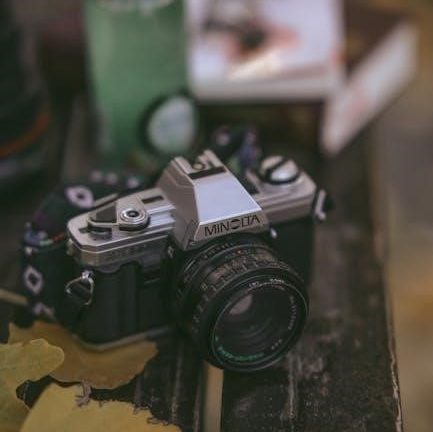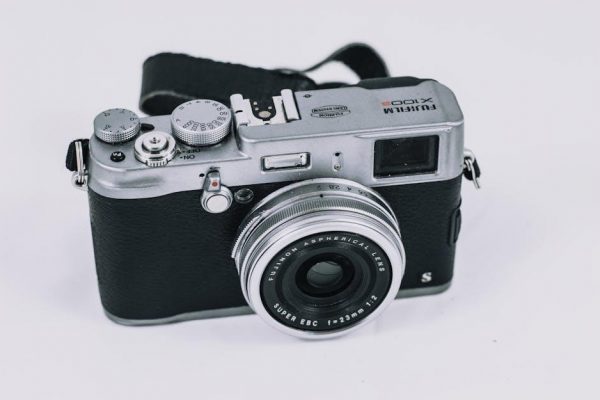The Minolta SRT 201 manual is a comprehensive guide for mastering this classic SLR camera. Available online in PDF format, it covers essential topics like film loading, focusing techniques, and exposure control, ensuring optimal use of the camera’s capabilities. This manual is indispensable for photographers seeking to unlock the full potential of their Minolta SRT 201.
1.1 Overview of the Minolta SRT 201 Camera
The Minolta SRT 201 is a high-quality, manual-focus single-lens reflex (SLR) camera designed for precision and durability. It features a wide ISO range of 20-1600 and adjustable shutter speeds from 1/1000th of a second to 1 second, plus bulb mode for long exposures. Compatible with M42 mount lenses, the SRT 201 offers versatility for photographers. Its manual controls provide precise operation, making it ideal for those who prefer hands-on photography. The camera is part of the Minolta SLR system, allowing use of interchangeable lenses and system accessories. With its robust build and advanced features, the SRT 201 remains a popular choice among film photography enthusiasts.
1.2 Importance of the Manual for Optimal Camera Use
The Minolta SRT 201 manual is essential for unlocking the camera’s full potential. It provides detailed guidance on operation, features, and maintenance, ensuring users can maximize the camera’s capabilities. The manual covers critical topics like film loading, focusing techniques, and exposure control, which are vital for achieving precise results. Additionally, it serves as a troubleshooting guide for resolving common issues and offers maintenance tips to extend the camera’s longevity. Available online in PDF format, the manual is a valuable resource for both novice and experienced photographers, helping them master the SRT 201’s manual controls and advanced features. It ensures optimal performance and enhances the overall photography experience.
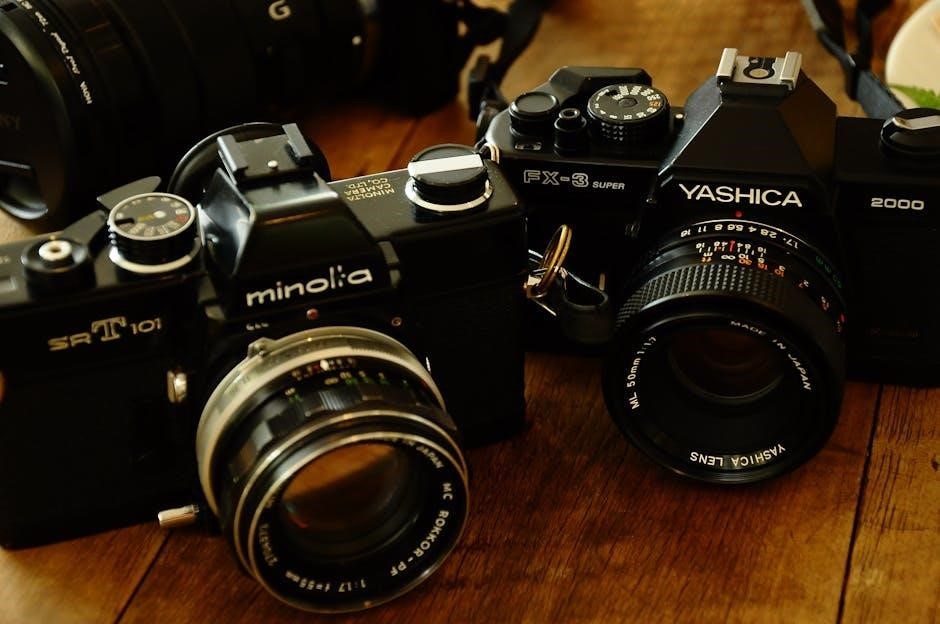
Key Features of the Minolta SRT 201
The Minolta SRT 201 is a durable, manual-focus SLR camera with M42 mount compatibility, featuring a wide ISO range (20-1600), adjustable shutter speeds, and bulb mode for long exposures.
2.1 Design and Build Quality
The Minolta SRT 201 boasts a robust and durable design, with a solid metal body that ensures long-lasting performance. Its ergonomic construction provides a comfortable grip, making it easy to handle during extended shoots. The camera’s build quality reflects precision engineering, with a focus on reliability and user satisfaction. The M42 mount system offers compatibility with a wide range of lenses, enhancing versatility for photographers. The manual controls are intuitively placed, allowing for seamless operation. Overall, the SRT 201’s design and build quality make it a reliable choice for both amateur and professional photographers seeking a dependable SLR camera.

2.2 Lens Compatibility and Mount System
The Minolta SRT 201 features the M42 screw-mount system, ensuring compatibility with a wide range of lenses. This universal mount allows photographers to use lenses from various manufacturers, offering flexibility and versatility. The camera’s lens compatibility is a significant advantage, as it supports both Minolta and third-party M42 lenses. The manual focuses on how to properly mount and use these lenses, ensuring optimal performance. With the M42 system, users can explore diverse focal lengths and specialized lenses, enhancing their creative possibilities. This compatibility makes the SRT 201 a versatile tool for photographers seeking to expand their lens collection and experiment with different shooting styles.
2.3 Manual Controls and Operation
The Minolta SRT 201 is renowned for its intuitive manual controls, offering precise command over exposure settings. The camera features a wide ISO range of 20-1600 and adjustable shutter speeds from 1/1000th of a second to 1 second, plus bulb mode for long exposures. Manual focus is straightforward, with a clear viewfinder and precise focusing ring. The manual provides detailed guidance on operating these controls, ensuring photographers can master techniques like metering, aperture adjustment, and film advancement. With its emphasis on hands-on control, the SRT 201 empowers users to achieve exacting results, making it a favorite among photographers who value creative precision and mechanical simplicity.
Understanding the Minolta SRT 201 Manual
The Minolta SRT 201 manual is a detailed guide available online in PDF format, providing comprehensive instructions for optimal camera use, maintenance, and troubleshooting.

3.1 Structure and Content of the Manual
The Minolta SRT 201 manual is structured to guide users through camera operation, maintenance, and troubleshooting. It begins with an overview of the camera’s features, followed by detailed instructions for loading film, focusing, and exposure control. The manual also covers advanced techniques like metering and long exposures. Key sections include troubleshooting common issues and maintenance tips for longevity. Available in PDF format, the manual is accessible online through platforms like ManualsLib and cameramanuals.org. It emphasizes understanding the camera’s CLC metering system and manual controls, ensuring users can fully utilize its capabilities. The content is designed to be user-friendly, catering to both beginners and experienced photographers.
3.2 Where to Find the Manual Online
The Minolta SRT 201 manual is widely available for free download in PDF format from various online sources. Websites such as ManualsLib, cameramanuals.org, and Butkus.org provide direct links to the manual, ensuring easy access for users. Additionally, platforms like Amazon and specialized camera forums often host downloadable versions. Some sites, like Butkus.org, request a small donation to support their efforts in hosting and maintaining these resources. Users can also find the manual through online marketplaces or camera enthusiast communities. These sources make it convenient for photographers to access the guide and master their Minolta SRT 201 camera.
3.3 Key Sections Every User Should Read
The Minolta SRT 201 manual includes essential sections that every user should review to maximize their camera’s potential. Key areas include film loading and initial setup, focusing techniques, and exposure control, which are vital for capturing high-quality images. Additionally, sections on ISO range, shutter speeds, and bulb mode provide detailed guidance for advanced photography. The manual also covers maintenance tips to ensure the camera’s longevity. Users should pay special attention to the metering system, manual controls, and compatibility with accessories. Reading these sections thoroughly will help photographers master the SRT 201’s features and improve their overall shooting experience.
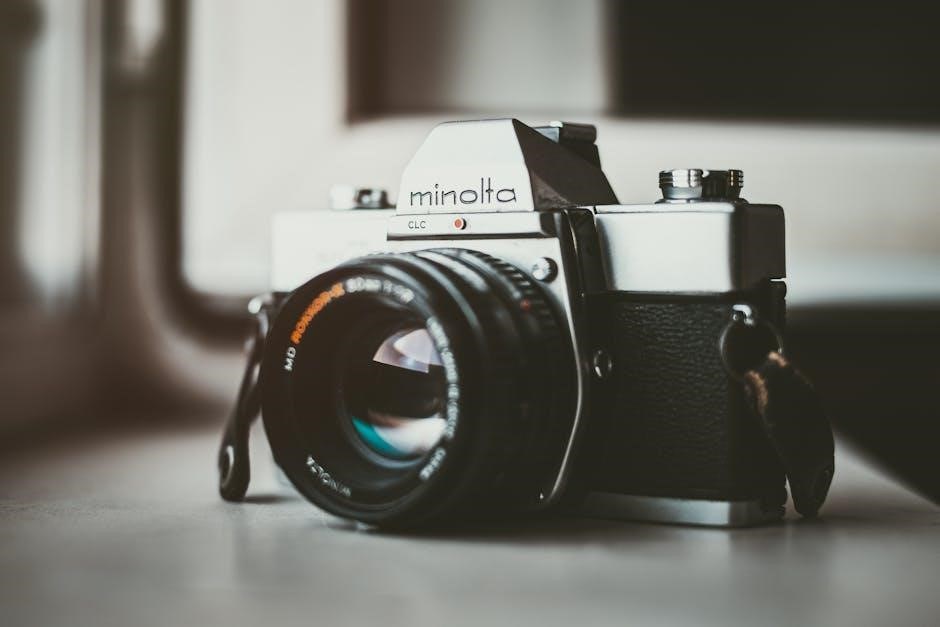
Operating the Minolta SRT 201
The Minolta SRT 201 manual provides detailed guidance on film loading, focusing, metering, and exposure control, ensuring optimal use of the camera’s capabilities for photographers.
4.1 Loading Film and Initial Setup
Loading film into the Minolta SRT 201 is a straightforward process. Open the camera back by releasing the latch and pull the film leader to align it with the take-up spool. Advance the film to the first frame using the rapid advance lever. Set the ISO by rotating the dial on the lens mount to match your film speed. Ensure the shutter speed is set to 1/60th of a second for metering. The camera’s CLC metering system will guide accurate exposures. Once loaded, check the shutter and aperture settings before shooting. Proper setup ensures optimal performance and image quality.
4.2 Focusing and Metering Techniques
The Minolta SRT 201 features a precise focusing system with a split-image microprism for accurate manual focus. For metering, the camera uses Minolta’s exclusive CLC (Contrast Light Compensator) system, which provides accurate exposure readings through the lens. To use the meter, align the needles in the viewfinder by adjusting the aperture or shutter speed. The camera’s light meter is activated when the shutter is cocked, ensuring real-time measurements. Proper focusing and metering techniques are essential for achieving sharp, well-exposed images. Practice these steps to master the camera’s capabilities and consistently produce high-quality photographs with the Minolta SRT 201.
4.3 Exposure Control and Shooting Modes
The Minolta SRT 201 offers precise exposure control through manual settings, allowing photographers to adjust aperture, shutter speed, and ISO for creative results. The camera features a wide ISO range of 20-1600 and shutter speeds from 1/1000th of a second to 1 second, plus bulb mode for long exposures. Exposure control is facilitated by the CLC metering system, which provides accurate readings through the lens. Users can choose between manual or aperture-priority modes, enabling flexibility in various lighting conditions. The manual provides detailed guidance on optimizing these settings for different shooting scenarios, ensuring photographers can achieve their desired artistic effects with ease and precision.
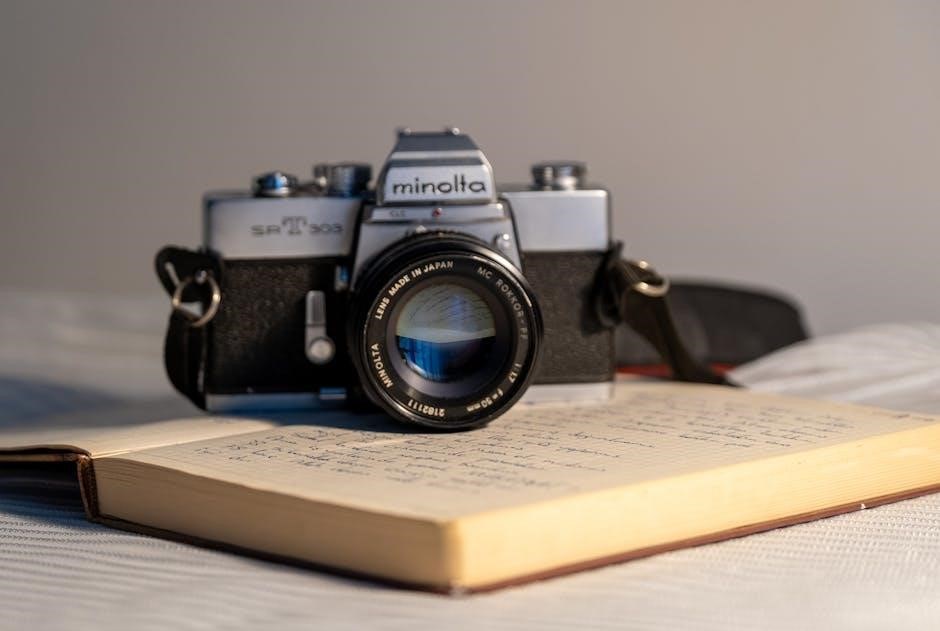
4.4 Maintenance and Care Tips
Proper maintenance ensures the longevity of the Minolta SRT 201. Regularly clean the lens and viewfinder with a soft, dry cloth to prevent dust buildup. Store the camera in a cool, dry place, away from direct sunlight and moisture. Avoid extreme temperatures, as this can damage internal components. For prolonged storage, consider using a silica gel packet to absorb humidity. Lubricate moving parts sparingly, if necessary, and avoid touching the mirror and shutter mechanism to prevent damage. Refer to the manual for specific care instructions to maintain optimal performance and preserve the camera’s functionality over time.
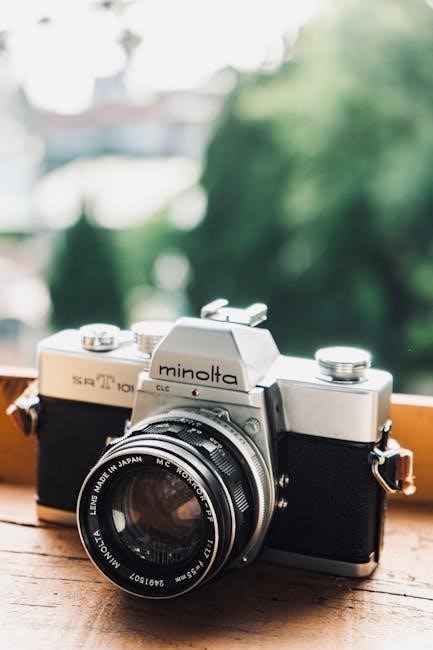
Advanced Features of the Minolta SRT 201
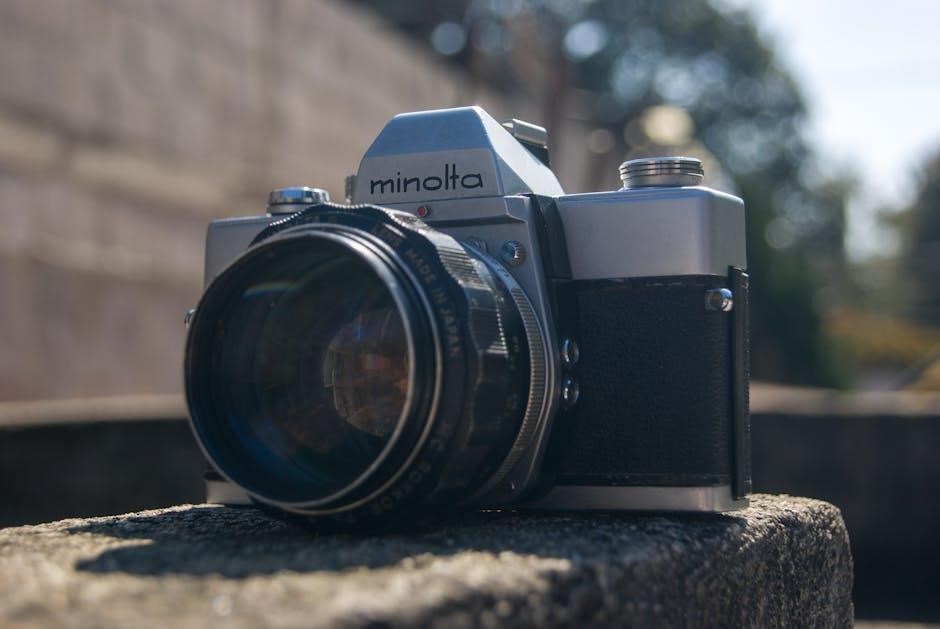
The Minolta SRT 201 offers a wide ISO range of 20-1600, adjustable shutter speeds up to 1/1000th of a second, and bulb mode for long exposures.
5.1 ISO Range and Shutter Speeds
The Minolta SRT 201 offers a versatile ISO range of 20 to 1600, providing flexibility in various lighting conditions. Shutter speeds range from 1/1000th of a second to 1 second, allowing precise control over exposure. This range is ideal for capturing sharp images in bright settings and creating artistic effects in low-light scenarios. The camera also features a bulb mode for long exposures, enabling creative techniques like light trails or star photography. These features make the SRT 201 a powerful tool for photographers seeking manual control and artistic expression. The combination of ISO and shutter speed options ensures adaptability to diverse shooting environments and creative needs.
5.2 Bulb Mode and Long Exposure Photography
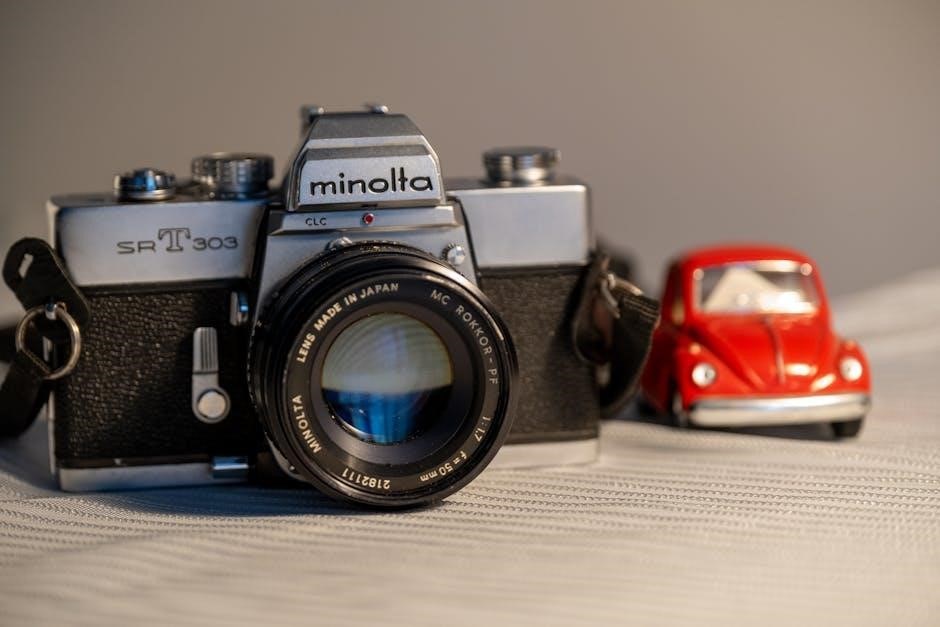
The Minolta SRT 201 features a bulb (B) mode, enabling extended exposures for creative photography. This mode allows the shutter to remain open as long as the release is pressed, ideal for capturing light trails, star movements, or artistic effects in low-light conditions. Bulb mode is particularly useful for long exposure photography, where manual control over exposure duration is essential. Photographers can experiment with various techniques, such as painting with light or creating ethereal landscapes. The camera’s manual operation ensures precise control, making it a versatile tool for photographers exploring advanced creative techniques. This feature underscores the SRT 201’s suitability for both professional and artistic applications.

5.3 Compatibility with System Accessories
The Minolta SRT 201 is part of the Minolta SLR system, offering compatibility with a wide range of interchangeable lenses and accessories. It supports M42 mount lenses, providing versatility for photographers to experiment with different focal lengths and specialized optics. Additionally, the camera is compatible with system accessories like flashes, viewfinders, and other components, enhancing its functionality for various shooting scenarios. This compatibility allows users to expand their creative possibilities, making the SRT 201 a versatile tool for both casual and professional photography. The ability to integrate with the Minolta system ensures that photographers can adapt their setup to meet specific needs, whether in the studio or the field.
Troubleshooting Common Issues
The Minolta SRT 201 manual helps resolve common issues like metering problems, focusing errors, and mechanical malfunctions. Regular maintenance ensures longevity and optimal performance.
6.1 Resolving Metering and Exposure Problems
Metering and exposure issues with the Minolta SRT 201 can often be resolved by ensuring proper battery function and clean lens contacts. If the meter needle does not move, check the battery or replace it. For incorrect exposures, adjust the aperture or shutter speed manually. The CLC system provides accurate readings, but aligning the viewfinder needles correctly is crucial. If problems persist, consult the manual for troubleshooting steps. Regular maintenance, such as cleaning the lens and prism, can prevent metering errors. Always refer to the manual for detailed guidance on resolving exposure-related issues effectively.
6.2 Addressing Mechanical and Focusing Issues
Mechanical and focusing issues with the Minolta SRT 201 can often be resolved through proper maintenance and adjustment. Clean the lens and mirror regularly to prevent dust buildup, which can affect focus accuracy. If focusing is inconsistent, check the lens alignment or consider professional calibration. Lubricate moving parts sparingly to maintain smooth operation. For stuck shutters, gently clean or replace faulty components. The manual provides detailed troubleshooting steps for common mechanical issues, ensuring your camera functions optimally. Regular servicing and careful handling will extend the lifespan of your Minolta SRT 201 and maintain its precision focusing capabilities.
6.3 General Maintenance for Longevity
Regular maintenance is crucial for extending the lifespan of your Minolta SRT 201. Clean the lens and mirror frequently to prevent dust buildup, which can degrade image quality. Use a soft cloth and mild cleaning solutions to avoid scratching surfaces. Lubricate moving parts sparingly to ensure smooth operation, but avoid over-lubrication, as it can attract dust. Store the camera in a dry, cool place to prevent moisture damage. The manual provides detailed guidance on cleaning and maintenance procedures. By following these steps, you can ensure your Minolta SRT 201 remains in excellent condition and continues to perform reliably for years to come.
Conclusion
The Minolta SRT 201 manual is a valuable resource for photographers, providing detailed guidance to unlock the camera’s full potential and ensure optimal use of its features.
7.1 Summary of Key Takeaways
The Minolta SRT 201 manual is a crucial guide for photographers, offering detailed insights into the camera’s operation and features. It covers essential topics such as film loading, focusing techniques, and exposure control, ensuring users can maximize the camera’s capabilities. The manual highlights the camera’s compatibility with M42 mount lenses, its ISO range of 20-1600, and adjustable shutter speeds from 1/1000th of a second to 1 second, plus bulb mode for long exposures. Additionally, it provides maintenance tips to prolong the camera’s longevity. By following the manual, photographers can master the Minolta SRT 201’s manual controls and unlock its full potential for high-quality photography.
7.2 Final Thoughts on the Minolta SRT 201 Manual
The Minolta SRT 201 manual is an invaluable resource for photographers, providing a comprehensive guide to unlocking the camera’s full potential. Its detailed instructions on film loading, exposure control, and maintenance ensure optimal use of this classic SLR. The manual’s availability online in PDF format makes it easily accessible, allowing photographers to master the camera’s manual controls and features. With its focus on durability and compatibility with M42 mount lenses, the Minolta SRT 201 remains a favorite among enthusiasts. The manual’s insights into advanced techniques and troubleshooting further enhance its utility. For anyone seeking to maximize their photography experience with the Minolta SRT 201, the manual is an essential companion.
